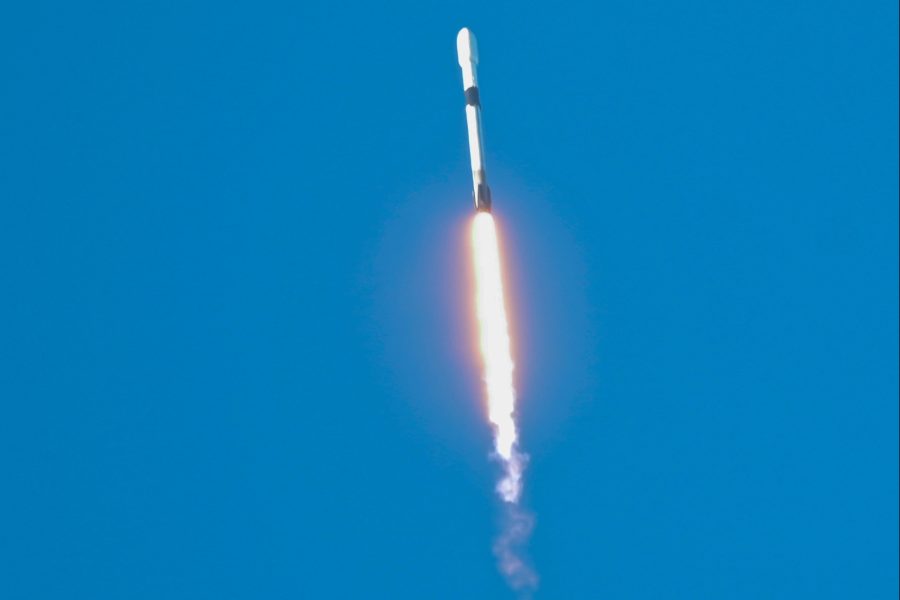Editor’s Note: Originally scheduled for Aug. 31, the launch attempt was delayed by SpaceX twice, before proceeding successfully Sept. 2. This story has been updated.
Nearly five months after the Space Development Agency celebrated the first launch of its massive planned satellite constellation in low-Earth orbit, the organization got their their second go-around Sept. 2.
Thirteen satellites from Tranche 0 of the Proliferated Warfighter Space Architecture headed into orbit from Vandenberg Space Force Base, Calif., on a SpaceX Falcon 9 rocket at around 7:30 a.m. local time.
Originally, the launch was scheduled for June, but a combination of factors pushed it backward—just as the first launch was delayed as well. Tranche 0 program director Mike Eppolito cited several reasons for both delays in a briefing with reporters Aug. 30: policy hurdles, delayed deliveries, and severe weather. Moving forward, Eppolito expressed confidence that as the agency procures more tranches and sets more launches, some of those issues will ease.
If for some reason the Aug. 31 launch is called off, there is a backup window available Sept. 1 at 7:26 a.m. Pacific time. The 13 satellites set to go up include:
- 10 data transport satellite manufactured by Lockheed Martin
- One data transport satellite from York Space Systems
- Two missile tracking satellites from SpaceX
Combined with the 10 that went up in early April, that will round out most of Tranche 0, which officials have dubbed the “warfighter immersion tranche,” as it will demonstrate capabilities that later tranches will operationalize and give service members the opportunity to work with the systems and understand their capabilities.
Originally, Tranche 0 was set to take only two launches. However, SDA officials told reporters they have changed their plans to include a third launch before the end of 2023, including four missile tracking satellites from L3Harris. That launch will be a collaboration with Missile Defense Agency, which is launching its own missile-tracking satellites as part of the Hypersonic and Ballistic Tracking Space Sensor program.
“The benefit of that will be that we’ll be able to see the same targets from both the MDA satellites and SDA satellites, demonstrating both the medium field-of-view and wide field-of-view tracking payloads all together on the same target,” Eppolito said. “So there’ll be tremendous benefit to having those satellites on that launch together with MDA.”
Officials also said that since the first launch, they decided to keep a York data transport satellite on the ground as a testbed—meaning Tranche 0 will consist of 27 satellites in orbit, 19 for data transport and 8 for missile warning.
“We understand that software development and the application that we’re going to run on board are going to be a critical enabling element for PWSA,” Eppolito said. “So we believe that having that testbed on the ground will pay off for both the current tranche in terms of demonstrating things before we update the [space vehicles] on orbit. It will also be able to be used for future tranches in terms of learning on that satellite, which could then be applied to future tranches.”
While the second batch of Tranche 0 is set to go up, the first batch are still getting going. In June, SDA announced it had received its first images from the missile tracking satellites, but the data transport satellites, which will be crucial for connecting sensors and shooters around the globe, have yet to maneuver to their final intended orbit or tested their ability to relay data to the ground using Link 16, the military’s tactical data network.
“We have some outstanding policy issues that are holding that up,” Eppolito said of the Link 16 tests. “But from a technical standpoint, we’ve gotten through all the checkout leading up until that policy hurdle. As soon as we get approval there, we plan to move forward with that checkout.”
Officials in the Pentagon and Congress are watching Tranche 0 closely as a proof of concept for SDA’s unique approach, which is defined by rapid timelines, numerous small spacecraft, and increased contractor competition. The first eight satellites went from contract to orbit in two and a half years, extremely fast for a military space program. SDA has already started awarding contracts for Tranche 2 and assigning launches for Tranche 1, with the hope of fielding new capabilities every two years and a steady stream of launches throughout.
